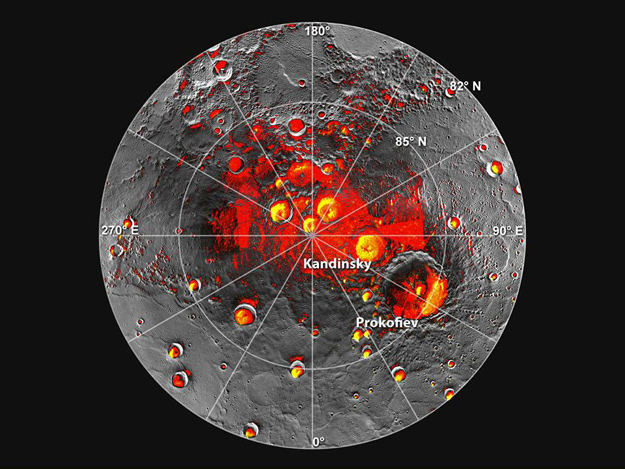MESSENGER Finds New Evidence for Water Ice at Mercury’s North Pole

NASA’s MESSENGER spacecraft has identified large concentrations of hydrogen at Mercury’s north pole, thought to be in the form of water ice, researchers announced today.
The hydrogen-rich layer, more than tens of centimeters thick and found in cold, permanently shadowed regions on Mercury, was identified using measurements from MESSENGER’s Neutron Spectrometer (NS). Planetary Science Institute Senior Scientist William C. Feldman provided the conceptual design for the NS, PSI Senior Scientist Thomas Prettyman provided critical analytical support for the research, and both scientists supported the interpretation of the data.
Feldman and Prettyman are co-authors of “Evidence for Water Ice near Mercury’s North Pole from MESSENGER Neutron Spectrometer Measurements,” published today on Science Express.
“The material itself near the surface is practically pure water ice,” Feldman said. “The most likely explanation is that there was a big comet impact in the past 50 million years or so that delivered water. Some of that water found its way to the poles to become ice, and most that ice later became covered by about 20 centimeters of soil or some other material.
“If there is water ice, it says there is a delivery mechanism for water ice to all the planets, and it tells us something of the history of the solar system, and how water was delivered to the innermost planets,” Feldman said.
David J. Lawrence of The Johns Hopkins University Applied Physics Laboratory, who was lead author on the paper said, “The MESSENGER neutron results could not have been completed with out Bill’s and Tom’s help. Bill provided the brains behind the design of the MESSENGER Neutron Spectrometer, and he and APL engineer John Goldsten were the primary drivers for the design and building of the NS. Tom provided critical support for our analysis using custom simulation codes to calculate the fast neutron response of the MESSENGER NS, which provides key information about the stratigraphy of the hydrogen.”
MESSENGER’s Neutron Spectrometer maps variations in the intensity of neutrons in three broad energy ranges: fast, epithermal, and thermal, in order of decreasing neutron energy. Fast neutrons are made by the interaction of high-energy particles called galactic cosmic rays, which steadily bombard Mercury’s surface. Neutrons undergo collisions with nuclei in the surface, steadily losing energy, passing through the epithermal energy range and approaching thermal equilibrium with atoms in the near-surface. Some of these neutrons escape into space and are measured by MESSENGER’s Neutron Spectrometer. The neutron energy distribution conveys information about the composition of Mercury’s surface, including the abundance and layering of hydrogen.
CONTACTS:
William C. Feldman
Senior Scientist
520-382-9238
feldman@psi.edu
Thomas Prettyman
Senior Scientist
505-690-5128
prettyman@psi.edu
PSI INFORMATION:
Mark V. Sykes
Director
520-622-6300
sykes@psi.edu
PSI HOMEPAGE:
http://www.psi.edu
PSI PRESS RELEASES:
http://www.psi.edu/news/press-releases
THE PLANETARY SCIENCE INSTITUTE:
Celebrating its 40th anniversary, the Planetary Science Institute is a private, nonprofit 501(c)(3) corporation dedicated to solar system exploration. It is headquartered in Tucson, Arizona, where it was founded in 1972.
PSI scientists are involved in numerous NASA and international missions, the study of Mars and other planets, the Moon, asteroids, comets, interplanetary dust, impact physics, the origin of the solar system, extra-solar planet formation, dynamics, the rise of life, and other areas of research. They conduct fieldwork in North America, Australia and Africa. They also are actively involved in science education and public outreach through school programs, children’s books, popular science books and art.
PSI scientists are based in 18 states and the District of Columbia, Australia, Canada, Ireland, Latvia, Russia, South Africa, Switzerland and the United Kingdom.









